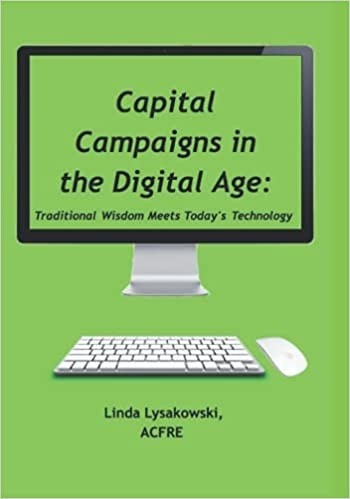
Best-Kept Secrets to Engaging and Retaining Business Donors
September 13, 2023
Involve Volunteers
September 13, 2023Capital Campaigns in the Digital Age: Traditional Wisdom Meets Today’s Technology
There are a lot of commonalities in campaigns, no matter what the size, the type of organization, or the purpose of the campaign. But there have been changes in the way campaigns are run in a digital age and these changes can be good for you and your campaign. While there are many factors that can affect the outcome of a campaign, and campaigns are always more successful if the organization has the following in place: The organization is prepared internally to run a campaign, the community responds well to the case for support, and the organization is able to recruit topnotch campaign volunteers. This book will help organizations of all sizes learn how to assess their readiness for a campaign, how to better prepare for a capital campaign, and how to organize their campaigns effectively, using today’s technology.
Another important goal of this book is to help development staff and other nonprofit leaders stop dreading the very words, “capital campaign” or to think that they cannot run a campaign when circumstances in their organization or the world change dramatically. After reading this book, you will come to realize that a well-run campaign, whether it is what you think of as a “traditional campaign,” or a “virtual campaign,” not only helps your organization achieve its immediate goal of a new building, a renovated building, or a strong program endowment. The ultimate result of a well-run capital campaign is that your organization is much stronger going forward. A successful campaign will help your organization increase its annual giving program, develop or strengthen a planned giving program, and, most importantly, advance its mission because of your successful fundraising program.
In this book, we discuss the changing technologies in the world of capital campaigns, a world that, while utilizing conventional capital campaign principles, is also flexible enough to adapt to the changing world around us. We’ll start with some basics–you will learn first what a capital campaign is and how it is both different from and similar to other fundraising efforts with which you may be more familiar. You’ll learn about the case for support and how it is developed and tested, usually through the planning study. The role of the board of directors in a capital campaign is critical and is discussed in this book. The staff role is equally important in a campaign. Often staff members are overly involved in running special events, writing grant proposals, public relations activities, and sometimes even assuming program responsibilities.
Volunteers are the key to a campaign’s success. Volunteer involvement shows the community that you have public support for your organization. This book explains the role of volunteers, how to find the right volunteers, and how to recruit and retain volunteers in today’s world. Of course, major donors are needed in any campaign, no matter what the dollar goal of the campaign, and in this book, you will learn how to identify, cultivate, and solicit donors and how this has changed. We will also talk about new methods of doing a planning study while not changing the tried and true processes; and how a study can help you prepare for a successful campaign.
You will learn how to organize your campaign—everything from the campaign plan and budget, campaign events and publicity, to organizing volunteers and recognizing donors. We talk about “life after the campaign.” dread of the very word, “campaign,” or even from a moderate comfort level with capital campaigning to true enthusiasm for the campaign and for that “dreaded technology.”


